| Reviews & Columns |
|
Reviews DVD TV on DVD Blu-ray 4K UHD International DVDs In Theaters Reviews by Studio Video Games Features Collector Series DVDs Easter Egg Database Interviews DVD Talk Radio Feature Articles Columns Anime Talk DVD Savant Horror DVDs The M.O.D. Squad Art House HD Talk Silent DVD
|
DVD Talk Forum |
|
|
| Resources |
|
DVD Price Search Customer Service #'s RCE Info Links |
|
Columns
|
|
|
Our Beloved Month of August
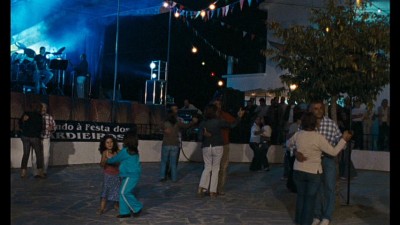
There's a confusing cut that comes even before the opening credits roll in Miguel Gomes's singular 2008 documentary-fiction hybrid Our Beloved Month of August: During what appears to be standard-style documentary footage of a rock band in rehearsal, the power goes out and the scene goes dark; we then cut back up to a scene of the exact same situation, as if the power has come back on after a few moments, but now we're looking at what is clearly another band playing in a noticeably different venue. This initial plunge into underemphasis and casualness, thwarting our expectations and unexpectedly taking us somewhere, possibly a loosely connected place (but we can't be entirely sure), we wouldn't have expected to be, makes a good preamble, preparing our senses in some small way for the quirks and challenges of the film we're about to see. The film does deal in large part with the thriving traditional/pop-rock musical scene in the North-Central Portuguese town of Arganil on the Alva River, a town full of natives with strong roots, hedonistic/hippie-ish Northern European emigrants, and, in the summer months, tourists from all over who enjoy the sun-drenched town with its music, dancing, ornate Catholic processionals, and annual carnival. But its musical-documentary side isn't the half of it:Our Beloved Month of August very freely mixes up varying approaches to its subject (which is, on the most general terms, the town/region of Arganil, its people, and its environs), calmly merging purely and self-evidently documentary-travelogue sections that capture panoramic landscapes and processionals with more intimate bits that tell tales of local characters, some ostensibly "real," others absolutely fictional, for a one-of-a-kind blend, Gomes's own secret recipe, that bursts with contrasting yet beautifully complementary flavors rarely (if ever) experienced in quite this way before in the cinema.
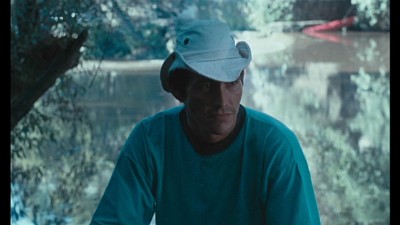
A recurring visual motif in the film -- a panorama seen through binoculars as a character scans a landscape -- offers another clue as to what's going on. Some of the characters are fire monitors, volunteers who while away their time watching through binoculars from little towers high up in the mountains surrounding Arganil, keeping watch for dangerous forest fires (one of these makes for a visually stunning plot twist in the strand of the film devoted to telling a straightforward dramatic story involving one of the area's musical families). These surveying binocular views make a handy metaphor for what Gomes is up to: There's a legend asserting that the film was initially meant to be a straightforward drama, shot in the Arganil area with locals cast in the roles, but then Gomes, upon arriving in and witnessing the place he meant to film, decided that such an idea was too small a concept to hold all he wanted to capture of the rich-to-overspilling community and nature he saw, so he decided to wing it while shooting and then layer the raw footage later into a more expansive, complete experience. Gomes is thereby, in his own way (at least according to the mythology around the film, which, whether factually accurate or not, works) much like one of those idly gazing but sometimes lifesaving binocular surveyors he has chosen to include, casting his eye hither and thither across a huge landscape, looking for a "fire" -- a main story for the film to tell -- to hone in on.

In that act of honing, which we experience as Gomes seems to try out and discard scattered and unrelated bits of different people's stories, we see the film in the actual process of "finding itself," and Our Beloved Months of August develops one of the most puzzling yet fascinating, and ultimately gratifying, structures of any picture I've seen in a long time: It tapers, initially alternating, at a very leisurely pace, footage of some of the town's many traveling bands in live performance and in interviews; of the water and mountains and deserts of the region; of some of its more eccentric inhabitants (a Dutch emigrant and a local ne'er-do-well called Paulo are salient); of people being cast for a film that's planning to shoot in town (it turns out to be the one we're watching); and of Gomes playing a recalcitrant film director verbally sparring with a producer's representative, who arrives and barges in (destroying a complicated opening-credits shot) with a script in his hand and is full of anxious questions from higher-ups about why that script is falling ever further by the wayside as Gomes and crew try to intuitively feel out what the film will be. The taper almost imperceptibly narrows, with no hurry or impatience (implying that everything we're seeing is of interest, and at least loosely related), so that the film's "dramatic" story fully emerges in the final third or so through scenes of one seasoned band leader in particular, Domingos (Joaquim Carvalho), that begin to recur more and more frequently in the apparently random alternation (which seems progressively less arbitrary as certain truly surprising connections and revelations are made). Domingos and his daughter, Tania (Sonia Bandeira) -- whom we realize we've already met as one of the tower-dwelling fire monitors -- have a tensely close, fraught relationship, which we learn is at least partly because she resembles to an alarming degree her mother, Maria Rosa, a woman who abandoned Domingos many years earlier, rendering him a single father and a brusque, stoical husk of a good-hearted man. Long-running tensions are brought to the fore by the forbidden love between Tania and Helder (Fabio Oliveira), her cousin (or, at least, the son of a couple who would be Domingo's in-laws were he still attached to Maria Rosa), exacerbating old familial conflicts and ending on a tearful note that resonates in the most old-fashioned, melodramatic way.
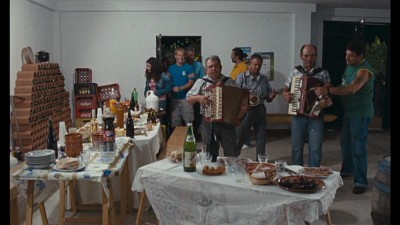
That the sad conclusion of Tania and Helder's romance is not the actual ending of the film, and that it then immediately begins to "untaper" by taking a self-reflexive step back from their story, doesn't undermine its dramatic power in the least, which is part of this Gomes's ultimately affirmative point -- his picture can contain multitudes, all of them achieving their individual and common aesthetic and/or narrative aims. The film actually closes for good, on a self-reflexive, magical-realist note, with a confrontation between Gomes and his sound recordist/engineer, Vasco Pimentel (with the film's crew, all playing themselves, surrounding them). Gomes asks Pimentel why the daily sound includes "too much" -- more, in fact, than what was audible as it was being recorded. The recordist's earnestly-delivered response provides a satisfying thematic conclusion that rhymes and resonates with the aforementioned confounding cut at the film's beginning, and with the motif of the eyes surveying and seeking through binoculars: It's yet another low-key, strange, affectionate metaphor for Gomes's wide-net ambitions, as Pimentel says he opens his ears and his microphone wide enough that they also encompass some extrasensory, quasi-spiritual plane; not just straightforwardly present sounds, but in fact anything that is relevant or fits as complement or commentary, are pulled in and included.
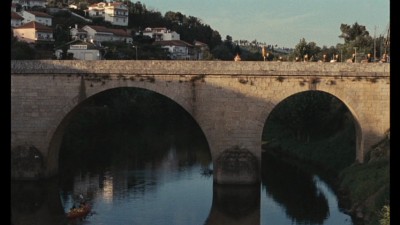
Our Beloved Month of August is thus an inclusive film, much more so than is common, with a patient pace and tone throughout that's redolent of all the generosity and even warmth that that term implies. And it's not just the ingenious sound design that's discreetly complex, often holding more layers than expected; the film is a visual delight too, always "on" and reflecting an open, exquisite sensibility on Gomes's part, so that what we see -- whether spontaneous-feeling, handheld/direct-cinema style views of a majestic, ritualistic religious parade; the same parade with figures tiny as ants as seen from a gorgeously composed, very wide static shot as it crosses Agranil's ancient Romanesque bridge; magically silhouetted close-ups of characters; or de-centered, anonymity-underlining, Antonioni-like views that miniaturize and de-emphasize characters in precisely composed shots that place them against sweeping, imposing architectural or natural backdrops -- is always as inventive and inspired as it is technically "meager." Indeed, the film makes a virtue of necessity; it may have been shot on 16 mm (by the supremely talented cinematographer Rui Poças, To Die Like a Man) and then blown up via a digital intermediate process to 35 mm, for a grittier, blurrier overall effect than standard 35 mm shooting, but what could have been a technical limitation or obstacle becomes instead the opportunity to explore possibilities of lighting and framing, and Gomes and Poças come up with a variety of eye-catching images that make the film a virtually nonstop visual treat. Their camera's way of taking in the film's world runs the gamut from playful to somber, from gritty/shaky framings and compositions to sublimely elegant ones, always ready to turn on a dime and ensure that we miss as few potential ways as possible of experiencing these surroundings, this culture, and these people. With a mind as enthusiastically curious and a visual sensibility as free-spirited and ravishing as Gomes's guiding us along, initially giving us just enough crumbs to keep us hanging on through what at first appears to be the film's morass before slowly, incrementally, almost unnoticeably savoring the pleasure of revealing its refreshingly creative, unfamiliar shape, Our Beloved Month of August accrues a singular power to overload and short-circuit your cinematic pleasure centers and distinguishes itself as one of the fleetest, supplest, most adventurous and uncategorizable films to appear on the DVD-release radar in a very long time.
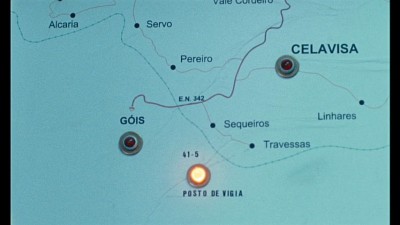
THE DVD:
The picture quality here, on a transfer that anamorphically preserves the film's original widescreen aspect ratio of 1.66:1, is fair to good. It was first shot on 16 mm and then blown up to 35 mm, which would account for some of the "blur" to the picture (which actually looks fairly natural and affords a texture the filmmaker seems well conscious of and is therefore able to use to its best advantage). However, there is a significant and often noticeable presence of edge enhancement that raises suspicions of overcompensation because of either a) overuse of digital noise reduction or b) unwillingness to let that natural 16mm-35mm transitional "blur" alone, with the haloing around characters and anything linear arising from an attempt to artificially sharpen the images. Whatever the explanation, it's my impression that the picture quality, though it's definitely at least passable, never unforgivably distracting, and does appear to retain a good level of celluloid texture/grain, could have been better with more careful treatment.
Sound:Sound is an element that turns out to be an important, playful, occasionally sneaky/disjunctive element of Our Beloved Month of August, and the Dolby Digital 2.0 stereo soundtrack (in Portuguese, with optional English subtitles), is near-flawless: All audio (much of it directly recorded in a documentary context, which makes its overall high quality even more impressive) is full, bright, and immediate, with no distortion or imbalance at any point to interfere with the film's subtly complex soundscape.

--Carnival: Looking for Paulo "Miller", a 2008 short made in accompaniment with Our Beloved Month of August, documenting Gomes's and his crew's hapless search, during 2007's carnival, for one of Arganil's most storied and elusive characters (who does, in fact, ultimately appear as an interviewee/player in the finished film). Paulo "Miller" is known for taking a dangerous jump into the Alva from a bridge each year during carnival, but what this film is about is, in keeping with the free-roving feature, much less the subject himself than Gomes and co.'s inability to pin him down; not only does he not do his famous jump during this year's carnival, but an ostensible technical/audio failure (as with the feature, it's very difficult to say how much of this film is "fact," how much invented) during Gomes's initial on-camera meeting with Paulo "Miller" leads to five minutes of lip-readers attempting to decipher their conversation.
--The best of the bonus features, Gomes's 2006 short film Canticle of All Creatures* (20 min.), is a riff on a text by St. Francis of Assisi, a triptych-film whose three parts -- one in which a present day folk-rock busker puts Assisi's words to music, with rough/handheld docu-footage of contemporary life; another that plays out as an exquisitely composed, artifice-drenched holy card in motion somewhat sacrilegiously depicting St. Francis's disillusionment with his utopian view of the natural kingdom; and a concluding third depicting the resolutely kill-or-be-killed, decidedly un-Christian natural world, with children reading in voiceover a rebuttal text that half-taunts, half-consoles Francis on having his head so nobly, inaccurately in the clouds when it came to nature. One assumes from this film that Gomes is a lapsed Catholic; it has all the beauty of that church's imagery, plus all the passionate critical-mindedness of one who's rejected its stifling, fantastical take on the world and human life.
--A pair of early shorts by Gomes -- 2001's 31 / Thirty-One Means Trouble (27 min.) and 2002's black-and-white travesty of silent-movie style, Kalkitos (19 min.) -- show a great talent in development, demonstrating some of the preoccupations and stylistic maneuvers of the mature Gomes that are further developed in Our Beloved Month of August, but also finding the filmmaker razzing Portugese politics/society (with no small degree of cleverness and skill) in an early mode of open indebtedness to the sensibilities of Bunuel and Lars von Trier -- a cocoon of obvious influence he would, by the time of Our Beloved Month of August, have worked his way through to burst forth with the vision and style all his own that we see in the disc's main feature.
--About 15 minutes of deleted scenes that are just about as beautiful as what's left in the final cut, though one gets the feeling that at least some of these clips were left out because they pull things a little more closely together than they are otherwise left in the completed film, and Gomes didn't want to give away his hand to that extent.
--The film's theatrical trailer.
Note: Canticle of All Creatures is incorrectly dated 2010 in the description on the back sleeve of this edition.
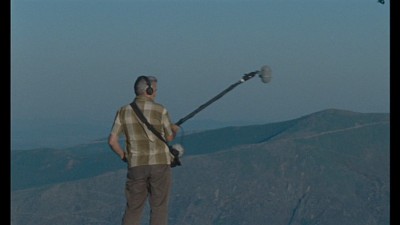
Easily, even nonchalantly existing in several dimensions all at once -- those of regional travelogue, musical documentary, melancholy family melodrama, and self-reflexive modernist mind-blower, to cite only the most salient genres sampled -- Portuguese filmmaker Miguel Gomes's Our Beloved Month of August is a film that has left itself purposely without a center. Its easy commingling of what seem like multiple different films at once, however, ultimately just feels like a happy letting-go of ordinary constraints, since it all has an aura of modesty, sincerity, and eagerness; there's no evident philosophical agonizing or self-conscious aesthetic/political agenda behind its odd makeup, just a self-effacing generosity of spirit that wants to show us everything it possibly can, the best way it knows how. Different sections of the film run in and out of each other, with not much to demarcate where fiction crosses over into nonfiction or vice versa. The setting for all of it is Arganil, a North-Central Portuguese town that rests some way away from the urban center of Coimbra on the river Alva -- a popular vacation destination (nevertheless possessing its own strong, inherent culture) that's teeming, especially in the summer months, with natives, emigrants, and tourists. The film's focus shifts from a survey of the region's beloved, robust musical scene, with its passion for romantic pop-rock balladeering and dance, to a fictional sub-story within that scene that involves a middle-aged musician, his grown daughter (who resembles, mysteriously and to an uncomfortable degree, her mother, the woman who left her father and broke his heart forever), and the musician's nephew, recruited to play for the band, who tragically falls in love with the daughter. There's also plentiful, languorous general documentation (sometimes including other fictional characters, sometimes not, and it's usually not altogether clear which is which) of the particular characters, routines, and attributes both human and geographical of the country around Arganil and the Alva, with its vast, mesmerizing natural beauty; and, to top it all off, scenes ("starring" Gomes and his crew) of the film itself in the act of being made. All these different sections of the film, succeeding each other in an order that at first seems random, don't necessarily bother to explain if or how they fit together, but as they begin to intermingle suggestively with each other at certain salient points, the film takes its unique shape, with moments of recognition and revelation that are more gratifying than any neatly tied-up narrative could ever be. It's a puzzle film, but one so genuinely interested in each piece that it never becomes a mere cerebral exercise or a race to make everything fit; its pattern reveals itself in its own time.
So many of the most notable movies that have worked in this documentary/fiction-hybrid vein -- those of Chris Marker, Godard, Jia Zhangke's 24 City, to name a few of the greatest -- mean to throw us off, to challenge, to jolt us into awareness and pose sticky questions about how fictional representation works (or doesn't) in relation to "reality," with an exploration and interrogation of that relationship the principal matter at hand. Our Beloved Month of August uses an approach similar to those vital works, but it comes into its own by taking a near-opposite trajectory, starting out by presupposing a question -- "Is it possible to mix together varieties of documentary and fiction in one film, fully maximizing the mystifications and pleasures available in all the forms encompassed, while at the same time doing full justice to the film's subject(s)?" -- and using its 2+ hours to leisurely but decisively form its answer. That response, to our great, happily befuddled edification, is an unequivocally affirmative one, making Our Beloved Month of August, for all its rejection of conventional narrative, a remarkably welcoming foray into one corner of the world via Gomes's personalized brand of elliptical storytelling, which creates a context that makes it difficult to tell what are the "main" or principally important parts of the film and what is digression, and impossible to decide which is more intriguing and rewarding. Highly Recommended.
|
| Popular Reviews |
| Sponsored Links |
|
|
| Sponsored Links |
|
|
| Release List | Reviews | Shop | Newsletter | Forum | DVD Giveaways | Blu-Ray | Advertise |
|
Copyright 2024 DVDTalk.com All Rights Reserved. Legal Info, Privacy Policy, Terms of Use,
Manage Preferences,
Your Privacy Choices | |||||||












